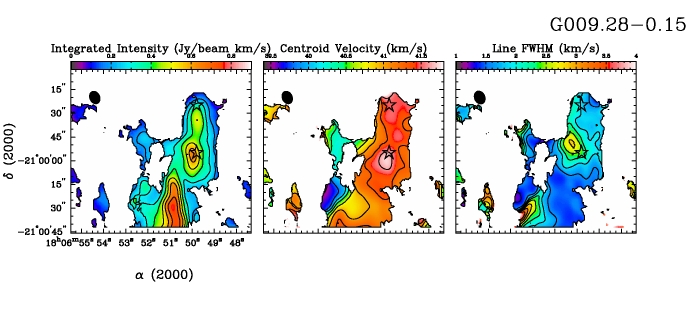| EPoS Contribution |
|
High-Resolution Mapping the Kinematic and Temperature Structure in IRDCs
Sarah E. Ragan Max-Planck-Institut für Astronomie, Heidelberg, Germany | |
| Infrared-dark clouds (IRDCs) represent an important phase in the early stages of massive star and cluster formation, thus understanding their internal physical conditions is crucial to constraining the initial conditions of this process. I present the results of a high-resolution study of six IRDCs using the Very Large Array. In this study, I show strong evidence for complex kinematical structure within IRDCs using ammonia observations, which also serves as a cloud thermometer. A 1-2 km/s range in centroid velocities is typically observed across the cloud, and residual velocity differences, representing core-to-core motions, are typically smaller than any observed ordered motion and are well below the virial linewidth. The largest velocity gradients uniformly appear at the edge of the ammonia core, which may point to cloud interaction with its envelope or residual motion from core formation. The presence of infrared point sources is often accompanied by an enhancement in line intensity and linewidth but little difference in the gas kinetic temperature. The scale of the linewidth enhancements, however, are small compared to typical outflow velocities. Thus ammonia may be probing the edge of the outflow-core interaction or perhaps tracing increased motions due to infall. Some IRDCs exhibit a slight rise in kinetic temperature in regions of low optical depth, i.e. near the cloud edges. With the addition of far-infrared Herschel data, probing precisely where the SED of embedded protostars peaks, the effect of the young sources on their natal gas will be known more fully. | |
 | |
| Caption: Spectral moments of IRDC G009.28-0.15 from VLA ammonia observations. The 24 micron point source detected with Spitzer are marked with stars. For the central 24 micron source, we see an enhanced linewidth and distinct velocity, thus we infer this to be an embedded protostar. The northern source has no such influence on the gas, and may no longer be associated with the gas or lies in the foreground. | |
| Collaborators: E. Bergin, U of Michigan, USA D. Wilner, SAO, USA |
Suggested Session:
Cores and Collapse, Herschel, Turbulence |

